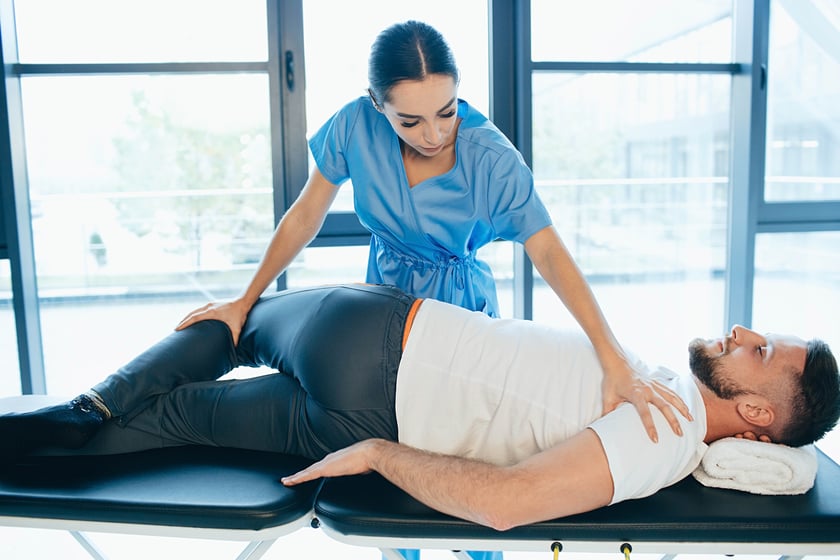
Lumbar spine injuries are those that affect the vertebra in the lower back. Injuries to this area are often severe, but unlike damage further up the spine, they are not life-threatening.

Common Lumbar Spine Injuries
Injuries to the lumbar spine are fairly common and range from minor to severe. The most common lumbar spine injuries include:
- Sprains and strains, caused by overstretching or tearing ligaments, tendons or muscles in the lumbar area;
- Disc degeneration, herniation or rupture, caused when the discs between the vertebra collapse or bulge, sometimes pressing on the nerves in the spinal cord;
- Radiculopathy, a condition caused by compression or injury to a spinal nerve root, of which the most common is sciatica;
- Spondylolisthesis, in which a vertebra slips out of place in the lumbar spine, pinching the nerves as they exit the spinal column;
- Trauma, causing the lumbar vertebrae to fracture or break, commonly caused by motor vehicle accidents, sporting accidents, and falls;
- Spinal stenosis, a narrowing of the spinal column that can cause pain and numbness, leg weakness and loss of sensation;
- Skeletal irregularities, such as scoliosis and lordosis, which cause abnormal curves in the spine that can become painful over time;
- Tumors occasionally spread to the back from elsewhere in the body as the result of cancer;
- Osteoporosis, a bone disease that can cause fractures in the vertebrae.
 While many of these conditions will cause lower back pain, those affecting the nerves in the spinal cord are the most serious. In particular, the trauma that results in broken bones in the spine can result in partial or total paralysis below the site of the injury.
While many of these conditions will cause lower back pain, those affecting the nerves in the spinal cord are the most serious. In particular, the trauma that results in broken bones in the spine can result in partial or total paralysis below the site of the injury.
Symptoms
The symptoms of lumbar spine injury will vary depending on how much damage is done to the spinal cord during the injury. The lumbar area of the spinal cord controls the nervous system’s signals to the lower parts of the trunk, pelvic area, and parts of the legs. This means that if the injury to the lumbar spine involves the lumbar nerves, typical symptoms include:
- Partial or total paralysis of the legs and hips
- Weakness of leg muscles
- Loss of physical sensation below the site of the injury
- Loss of bowel and bladder control
- Sexual dysfunction
- Pain in the area of the injury
The upper body is not usually affected by lumbar spine injuries.
Complete and Incomplete Lumbar Spinal Injuries
Medical professionals commonly describe injuries to the spinal cord as “complete” or “incomplete”. In a complete injury, the patient has a total lack of sensation and motor function below the injury. Complete injuries are usually permanent, as the spinal cord does not repair itself over time. In an incomplete injury, the patient will still have some or full sensation and movement below the site of their injury, and they may recover more function over time.
What are the Treatment Options Available?
Treatment for lumbar spine injuries will vary depending on the severity of the injury. However, the typical process for treating serious injuries to the lumbar spine would be:
1. Immobilization
The first step in the treatment of a spinal injury is to immobilize the area to prevent the injury from getting worse. In the case of damage to the lumbar spine, the patient will usually be strapped to a backboard for transport to the hospital. Once at the hospital, the patient may be placed in traction to try and stabilize the spine. Steroids may also be recommended to reduce inflammation, although as these run risks for patients with spinal cord injuries, the patient’s physician will need to decide if they are appropriate.
2. Surgery
In many cases of lumbar spine injury, surgery will be advisable to reduce any pressure on the spinal cord, for instance, by removing any broken bone fragments or excising a tumor pressing on the spinal nerves. In some instances, metal screws, rods, and plates may be inserted to stabilize and increase support around the spine while the bones heal.
3. Follow-Up Treatments
Many complications can result from injuries to the lumbar spine, including bowel and bladder incontinence, blood clots and circulation issues, muscle spasms, chronic pain, and depression. After the initial surgery, resulting complications from the injury may require further surgery and/or medication. Once the patient’s injury has been treated, the medical focus will move to rehabilitation.
How Can Orthopedic Rehab Help Patients Recover from Lumbar Spine Damage?
According to MedicineNet, “Aggressive physical therapy and rehabilitation after surgery maximizes recovery.” For most patients with lumbar spine injuries, the majority of their recovery will take place within the first six months after injury. For lumbar spine patients, rehab will most likely take place in a specialized orthopedic rehab facility. Orthopedic rehab focuses on restoring mobility and motor function, building strength, and helping the patient to manage their new physical state as well as they can. Key benefits for lumbar spine patients include:
A Customized Orthopedic Treatment Program
Lumbar spine injuries vary widely and cause a broad range of challenging physical symptoms. In a specialist center for orthopedic rehab, the rehab team carefully evaluate every patient upon arrival to develop a clear understanding of their unique physical and mental condition and issues. The team will then work collaboratively to put together a holistic treatment program specifically designed for the patient.
Specialized Treatment
One of the main benefits of an orthopedic rehab program is the opportunity to work with a team of highly specialized medical professionals. Their depth of experience and knowledge about lumbar spine injuries ensures that the patient receives the highest possible level of care and access to the latest developments in spinal care treatment. In many cases, rehab centers will offer patients access to technologically advanced care techniques, such as state-of-the-art electric nerve stimulation devices, to improve nerve responsivity in the lumbar spinal cord.
Continuum of Care
Orthopedic rehab specialists can help support the patient during transitions of care – from hospital to rehab, and from the rehab facility to the patient’s home. This “continuum of care” helps to make sure that the patient can transfer seamlessly between locations and ensures that the patient receives the treatment they need at all times.
Rehab teams work together closely to make sure that the patient’s physical, emotional, nutritional, and practical needs are all taken care of, both during and after rehab. Communication between the patient, the rehab team, and the patient’s loved ones is treated as a priority, which makes the process of recovery easier for everyone involved. This not only improves the health outcomes for the patient, but it also reduces their risks of rehospitalization.
Improved Patient Outcomes
Lumbar spinal injuries are serious, and in the case of complete spinal cord damage, the patient may never recover the use of their lower limbs. However, while a full recovery may not be possible, orthopedic rehab can help lumbar spine patients manage their condition better, restore a higher quality of life, adapt to their new physical reality, experience less pain, build up muscle strength, and deal with the emotional aspects of their injury.
Recovery from a lumbar spine injury can be challenging, but orthopedic rehab plays a crucial role in improving patient outcomes. To find out how Rehab Select helps patients with lumbar spine injuries recover, contact us to learn more.




